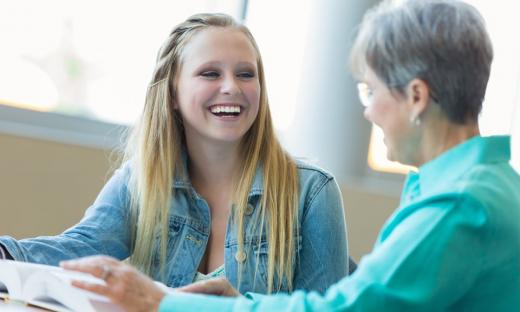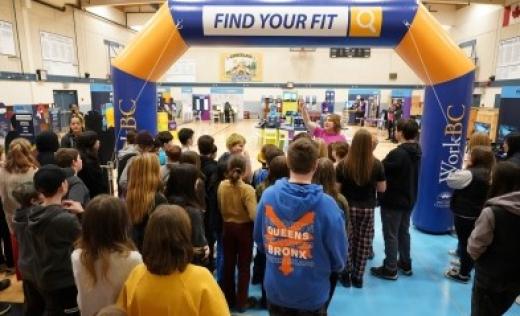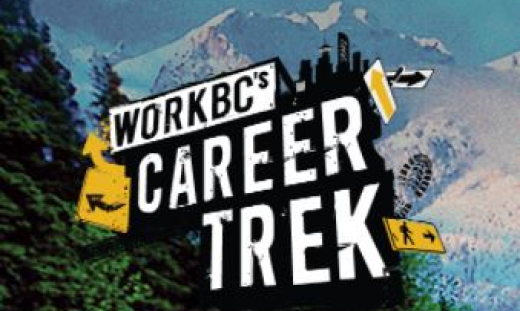This learning activity supports student career exploration and learning before, during and after the Find Your Fit (FYF) event, for students in grade 5 through to Career-Life Connections (CLC).
The Find Your Fit learning activity supports student career exploration and learning before, during and after the Find Your Fit (FYF) event. The FYF event is a great launching point for educators to help students understand the connection between career choices and their personal skills, abilities and knowledge. Educators may want to deliver the Career Discovery Quizzes lesson or have students complete several of the quizzes to help them make connections between personal attributes and careers.
Resources for FYF
Supplementary Resources
Worksheet A: Find Your Fit (available for download)
Skills For Success - Skills Competences Canada
Extension Lessons: Additional lessons that may be useful for creating a unit on the personal attributes.
Australia Victoria School Board Lesson: My Talent: Lesson 1_Year 7 (PDF) (education.vic.gov.au)
Other Requirements: Computer, tablet or smartphone.

This lesson supports student career exploration and learning before, during and after the Find Your Fit (FYF) Tour event. The FYF event is a great launching point for educators to help students understand the connection between career choices and their personal skills, abilities, and knowledge. Educators may want to deliver the Career Discovery Quizzes lesson plan or have students complete several of the quizzes to help them make connections between personal attributes and careers.
- What skills, qualities, and personal experiences (attributes) do I have that I can continue learning or establish for my career path?
- Which personal attributes are most important to me? Which ones do I think I will use to help guide my life/work plans?
- During the Find Your Fit event, which occupation was most interesting to me and what about it caught my attention?
- During the Find Your Fit event, which skills was I good at and/or was I surprised I could master?
- After the Find Your Fit event, when I researched the occupation, what were several things I learned that may help me make career planning decisions.
- Did participating in the Find Your Fit activity make me more aware of career possibilities? Did it help me refine my initial career and education goals and plan? If so, what was the change?
- Did I store my work for future reference and use in my career education courses or capstone project?
This lesson supports student experiential learning and career exploration before, during and after the Find Your Fit (FYF) tour event. The FYF event is a great launching point for educators to help students understand the connection between career choices and their personal skills, abilities and knowledge. Educators and students can leverage this exploration and learning to help students explore career options and refine their learning and/or career plans.
The introductory activity will help set the stage for students to reflect on the personal attributes they have already developed and how those attributes might relate to the occupational skills that will be show cased during the FYF tour event. During the event, students will be given a task as to what to look for during the experience. After the event, students will have the opportunity to research two occupations that were showcased and reflect on their FYF experience and how it changed their view of their own skills, abilities and knowledge and potential career choices.
All the activities in this lesson encourage young people to think about the skills, qualities and experiences they have that could lead them to future employment or education opportunities that match their personal attributes.
Educators can customize the lesson to meet the grade specific curriculum outcomes.
Students will:
- Identify and discuss personal skills, qualities and experiences they currently have that are transferable to future learning and/or employment situations.
- Explore several occupations and the associated skills through participation in the Find Your Fit event.
- Reflect on the experiences they had and skills they practiced during the Find Your Fit event to identify occupations and skills they practiced that may be new to them.
- Using WorkBC resources, research at least two FYF showcased occupations to determine if either occupation may be of interest to them to pursue further through education or work experience.
- Reflect on the career possibilities and begin to think about the next steps on their career journey.
Students will identify their personal strengths, skills, abilities and knowledge they have developed over time: at school, in the community or through volunteer work.
- Introduce an example to link the personal identity concept to careers—people who are in a career they love often have a strong connection with what the career says about them and often see it as an important part of their identity. It impacts where they live, what they wear and with whom they associate. Often people gravitate to work (occupations) that are an extension of the things they do well and/or like to do. Explore through conversation how one’s hobbies and interests link to courses they are taking; part-time work they gravitate to or career choices they are exploring.
- Ask students to draw three overlapping circles (Venn diagram) on a piece of paper. These should be headed: Work experience; School courses, hobbies and interests; Volunteering or community projects.
- Inside each circle ask them to put details of things they have done and the skills or qualities developed in that activity. For example, someone who has had work experience may have acquired timekeeping and reliability qualities and developed IT skills. Or someone who volunteered at a summer camp may have acquired organizational and leadership skills. Or someone who is taking a cooking class may have acquired problem solving, measurement and creativity skills. Any skills or qualities that are repeated should be noted in the overlapping sections.
- Next, ask students to use a highlighter pen or pen to highlight or circle the skills and qualities they think employers look for or that will help them succeed at completing courses at school or during volunteer work. These can be in any of the three circles.
- Ask the students to share their findings and pull out some of the key attributes employers might look for, such as technology, communication and organizational skills. As well, ask students to circle the key attributes they think is their strength and may help them pinpoint future course work they want to pursue or to help them explore future career directions.
- Create a master skills/abilities and interests list to showcase the attributes all the students in the class have already developed. Point out all these attributes help people make position transitions to work and learning. (Project list on a screen or create a poster board/flip chart). Save for Activity Two.
- Point out that even if a young person has never worked, they will have skills and qualities that will be beneficial to helping them make career plans (work and learning choices).
Using the information provided to you about the FYF event, talk with the students about the FYF event and what they can expect. Let them know they will have a chance to explore various occupations and experience what it’s like to work in the occupation by participating in some hands-on activities.
- Show the following video to the class: About the Find Your Fit Tour and highlight the skills that are featured at each workstation and how students will be able to practice some of the key skills that each occupation needs to have to be successful at their job.
- Show them the WorkBC skills poster or project the list of skills and their definitions that can be found on the Skills for the Future Workforce webpage. Using the master skills list created in Activity One, circle the skills that match the WorkBC list. There may be some skills on the WorkBC skills poster that were not identified during Activity One. Ask students if they think they have already developed some of the skills and if so which ones. Add those to the Activity One skills list.
- Let students know that each of the occupations featured at the FYF event, will showcase a sample of the skills that a person needs to be able to have mastered to be good at the job they are working at.
- Visit the career profiles on the WorkBC.ca website to show the occupations showcased at FYF. This information will be sent to teachers prior to the FYF event. Review the work-related skills to show students some of the skills they will see demonstrated at the FYF event. (THESE would be good to have links for right in the lesson, assuming the occupations are ones that are showcased at the event.
Assign the following to be completed during the FYF event:
- During the event ask students to record – either on a piece of paper, their mobile/tablet or take a photo – the occupations they observed and several skills for each occupation that were demonstrated or that they practiced.
- Ask them to think about which of the occupations that were showcased were of most interest to them. Ask them record two occupations they would want to learn more about.
- Remind students to keep the information gathered at the FYF event and bring the information to the next class.
The final part of the learning activity will focus on encouraging students to think about their future career options through the lens of subjects of interest, abilities, and work preferences and any new skills they mastered or observed at the FYF event.
- Debrief the FYF event to get feedback on what students thought about their experience – did they find out about new occupations, what was their favourite occupation station, were there any new skills they learned, did they find they excelled at a skill they already knew how to do? This is also an opportunity to make connections to school courses they are taking, such as ADST, careers, technology, math or science.
- Project or list on a flipchart the occupations that were showcased at the FYF event. Take a vote on which occupation students liked the most. Use the most popular occupation to demonstrate how to conduct research using one or more of the WorkBC career search tools.
- Ask students to individually reflect on the event, choose two occupations they are curious about and complete Worksheet A: Find Your Fit. Demonstrate the following websites found on WorkBC and suggest they use one or all of these to complete their work. Tip: students will need to select “View Career Profile” for complete information on the occupation.
- Explore Careers – Search by keyword.
- Explore Careers – Search by A-Z Career Profile Search.
- Career Search Tool – Search by Filters such as region, education, occupational interest.
- Career Trek – Search video files to view work in progress.
- Once students have completed their work, create an exit slip, or set of reflection questions to have them think about the new things they learned about work and themselves.
Self-Assessment
Ask students to provide evidence of the statements:
- I identified skills, qualities, and personal experiences (attributes) I currently have that I can leverage to continue learning or establish my career path.
- I reflected on my personal attributes and determined which were the most important to me and which ones I think I will use to help guide my life/work plans.
- During the Find Your Fit event, I identified the occupation that was most interesting to me and what caught my attention.
- During the Find Your Fit event, I identified some of the skills was I good at and/or was surprised I could master.
- After the Find Your Fit event, I researched the occupation, and found information that could help me make informed career planning decisions.
- Participating in the Find Your Fit activity made me more aware of career possibilities and refined or confirmed my initial career and education goals and plan.
- I stored my work for future reference and use in my career education courses or capstone project.
Teacher Assessment
Teacher creates a marking rubric related to the three learning activities for the items they want to collect for assessment.
This lesson plan supports elements of British Columbia's Career Education Curriculum as outlined below. For further details on the curriculum itself, visit the Ministry of Education's Career Education Curriculum webpage.
Grade 5
- Exploring your strengths and abilities can help you identify your goals.
Grade 6/7
- New experiences, both in and outside of school, expand your career skill set and options.
Grade 8/9
- Reflecting on your preferences and skills helps you identify the steps you need to take to achieve your career goals.
Career-Life Education (CLE)
- Career-life choices are made in a recurring cycle of planning, reflecting, adapting and deciding.
Career-Life Connections (CLC)
- Career-life development includes ongoing cycles of exploring, planning, reflecting, adapting and deciding.
Grade 5
Personal development:
- Problem-solving and decision-making strategies.
Grade 6/7
Personal development:
- Self-assessment.
Grade 8/9
Personal development:
- Self-assessment for career research.
- Reflection.
Career-life plan:
- Post-graduation opportunities.
CLE
Career-life development:
- Competencies of the educated citizen, employability skills, essential skills, leadership and collaboration skills.
- Self-assessment and reflection strategies.
CLC
Career-life development:
- Reflection strategies.
- Self-assessment to achieve goals that advance preferred career-life future.
Grade 5
- Examine: Identify and appreciate their personal attributes, skills, interests, accomplishments and their growth over time.
Grade 6/7
- Examine: Recognize their personal preferences, skills, strengths, and abilities and connect them to possible career choices.
- Experience: Appreciate the value of new experiences, innovative thinking and risk-taking in broadening their career options.
Grade 8/9
- Examine: Use self-assessment and reflection to develop their graduation and post-graduation plans.
- Examine: Make connections between career-related experiential learning and potential career paths.
- Experience: Apply decision-making strategies to a life, work, or community problem and adjust the strategies to adapt to new situations.
CLE
- Experience: Explore and connect experiential learning, both in and outside of school, with possible and preferred career-life pathways.
CLC
- Examine: Assess personal transferable skills and identify strengths and those skills that require further refinement.
- Experience: Engage in, reflect on, and evaluate career-life exploration.
Communication:
- Acquire, interpret and present information.
Critical thinking:
- Ask questions, consider options and draw conclusions.








